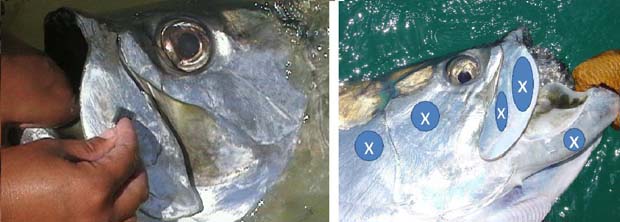Tarpon anglers are invited to assist researchers by safely and harmlessly removing, storing, and delivering samples of skin cells of captured tarpon
 [dropcap]T[/dropcap]arpon can be identified using DNA fingerprinting, or “fin printing,” techniques. Genetic samples collected by the angling public (like you) can be used to determine recapture rates, health, migration, and movements of individual fish. By evaluating these factors on recaptured fish over time, biologists at the FWC’s Fish and Wildlife Research Institute (FWRI) and partners at Mote Marine Laboratory can assess the success of tarpon stocks and the connectivity of, or relationship between, tarpon and different bodies of Florida waters.
[dropcap]T[/dropcap]arpon can be identified using DNA fingerprinting, or “fin printing,” techniques. Genetic samples collected by the angling public (like you) can be used to determine recapture rates, health, migration, and movements of individual fish. By evaluating these factors on recaptured fish over time, biologists at the FWC’s Fish and Wildlife Research Institute (FWRI) and partners at Mote Marine Laboratory can assess the success of tarpon stocks and the connectivity of, or relationship between, tarpon and different bodies of Florida waters.
In other words, researchers can use the tarpon recapture information to answer questions such as these: Will a tarpon that was caught and genetically sampled in the waters by Egmont Key near the mouth of Tampa Bay get recaptured down in the Florida Keys? If so, could the tarpon then swim toward the Sebastian Inlet near Melbourne, or will the tarpon return to Tampa Bay? To view DNA Project – click here […].
How do you genetically sample a tarpon?
A small sample of skin cells is all that is needed. There’s no need to place an external plastic or wire tag on the fish that can fall off, break, or get covered in algae beyond recognition. A tarpon’s DNA provides a natural tag of sorts that lasts as long as the tarpon is alive–and a tarpon can live over 60 years.
Using a small abrasive sponge to scrape skin cells from the outer jaw of the tarpon provides enough DNA for researchers to determine whether a particular fish has been caught and sampled before. View Methods and Tips – click here […].
These skin cell samples are relatively easy to take without harming the fish. A tarpon can be left in the water while taking the sample alongside the side of the boat, so no possession tag is required to participate in this study. Each sample is processed at the FWRI laboratory in St. Petersburg at a minimal cost to the project of less than $3 each. The technology allows FWRI biologists to identify an individual tarpon’s unique DNA “fingerprint” with the odds of an error at less than one in a billion. In fact, as of March 2012, we have already identified approximately 100 recaptured tarpon since the study started in 2005.
Please consider becoming a volunteer today. The study relies on tarpon anglers to obtain the samples. So far, thanks to public support and participation, over 9,000 samples have been collected. To learn more about the study and how to participate, view an educational video which includes step-by-step instructions. To obtain a DNA sample kit (view instructions), call 1-800-367-4461 or e-mail TarponGenetics@MyFWC.com. The kits have no expiration date, and no refrigeration is required to store a sample. Just remember to fill out the data slip when a DNA sample is taken. A pencil is provided in the kit.
DNA samples from any tarpon, regardless of size or location of capture, can be dropped off at one of our statewide collection locations, which also provide replacement DNA sample kits, or turned in to FWRI. For more information, contact FWRI by clicking here […].



